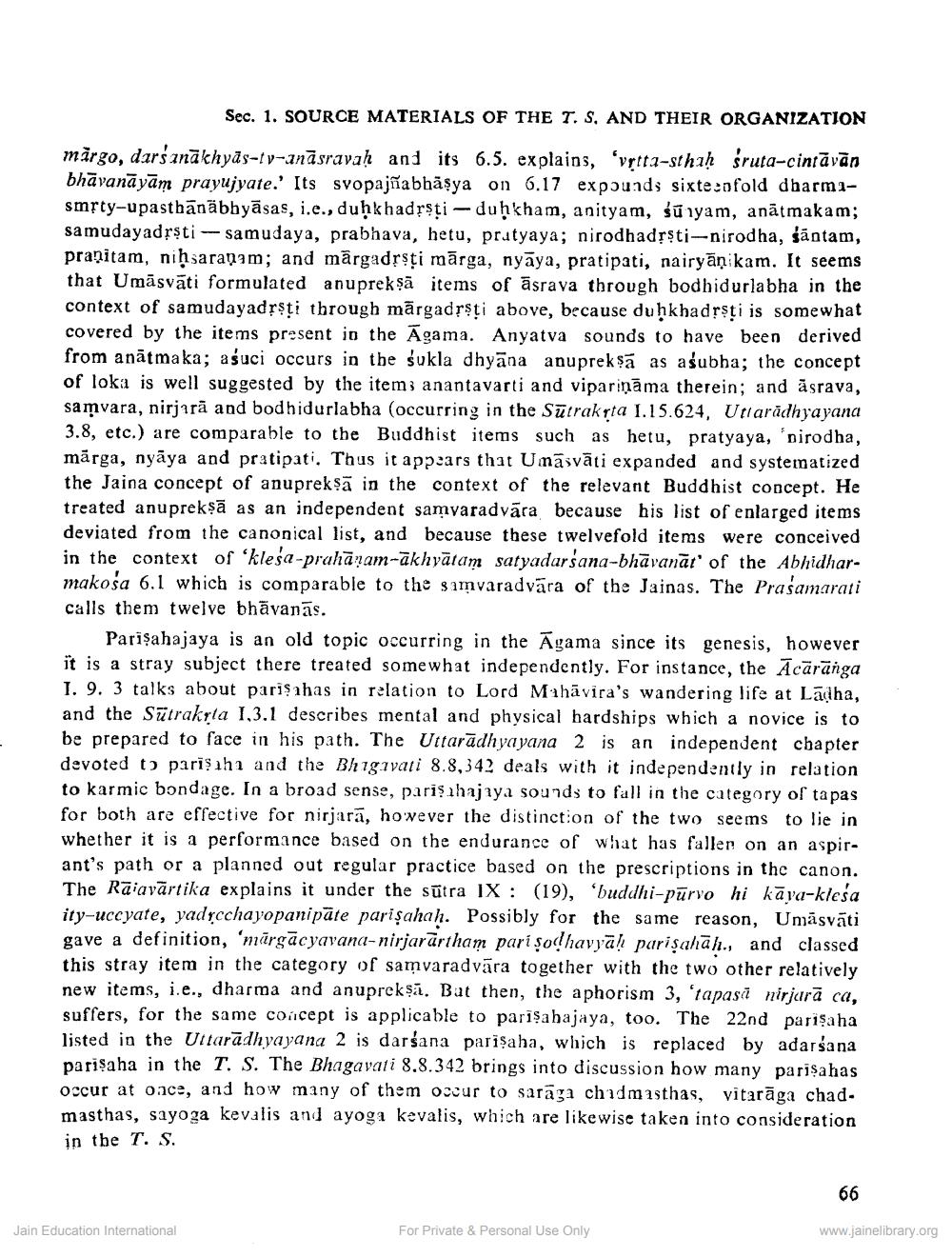________________
Sec. 1. SOURCE MATERIALS OF THE T. S, AND THEIR ORGANIZATION
margo, darsanākhyās-tv-anāsravah and its 6.5. explains, 'votta-sthiḥ śruta-cintāvān bhāvanāyām prayujyate.' Its svopajñabhäşya on 6.17 expounds sixteeofold dharmasmrty-upastbānäbhyāsas, i.e., duḥkhadrsţi - duḥkham, anityam, sūıyam, anātmakam; samudayadrști – samudaya, prabhava, hetu, prutyaya; nirodhadssti-nirodha, śāntam, pranitam, nih saranam; and märgadrsţi mārga, nyāya, pratipati, nairyān kam. It seems that Umāsvāti formulated anupreksā items of āsrava through bodhidurlabha in the context of samudayadrșți through mārgadssti above, because duḥkhadrsti is somewhat covered by the items present in the Agama. Anyatva sounds to have been derived from anātmaka; aśuci occurs in the sukla dhyāna anupreksā as aśubha; the concept of loka is well suggested by the items anantavarti and vipariņāma therein; and asrava, samvara, nirjasă and bodhidurlabha (occurring in the Sūtrakta I.15.624, Uttarădhyayana 3.8, etc.) are comparable to the Buddhist items such as hetu, pratyaya, pirodha, mārga, nyāya and pratipati. Thus it appears that Unāsvāti expanded and systematized the Jaina concept of anupreksā in the context of the relevant Buddhist concept. He treated anupreksā as an independent samvaradvāra because his list of enlarged items deviated from the canonical list, and because these twelvefold items were conceived in the context of 'klesa-prahāram-ākhyātam satyadarsana-bhāvanāt' of the Abhidharmakosa 6.1 which is comparable to the simvaradvāra of the Jainas. The Prasamarati calls them twelve bhāvanās.
Parişahajaya is an old topic occurring in the Agama since its genesis, however it is a stray subject there treated somewhat independently. For instance, the Ācāränga 1. 9. 3 talks about pariş ahas in relation to Lord Mahāvira's wandering life at Ladha, and the Sūtrakrla 1.3.1 describes mental and physical hardships which a novice is to be prepared to face in his path. The Uttarādhyayana 2 is an independent chapter devoted to parishi and the Bhigavati 8.8,342 deals with it independently in relation to karmic bondage. In a broad sense, parisahajıya sounds to fall in the category of tapas for both are effective for nirjarā, however the distinction of the two seems to lie in whether it is a performance based on the endurance of what has faller on an aspirant's path or a planned out regular practice based on the prescriptions in the canon. The Rāiavārtika explains it under the sūtra IX : (19), 'buddhi-pūrvo hi kāya-klesa ity-uccyate, yadyochayopanipāte parişahah. Possibly for the same reason, Unāsvāti gave a definition, 'mārgācyavana-nirjarartham pari şodhavyāḥ parişahāh., and classed this stray item in the category of samvaradvāra together with the two other relatively new items, i.e., dharma and anuprekşā. But then, the aphorism 3, tapasi nirjurā ca, suffers, for the same concept is applicable to parişahajaya, too. The 22nd parişaha listed in the Ultarādhyayana 2 is darśana parişaha, which is replaced by adarsana parişaha in the T. S. The Bhagavati 8.8.342 brings into discussion how many parişahas occur at once, and how many of them occur to sarāga chidmasthas, vitarāga chad. masthas, sayoga kevalis and ayoga kevalis, which are likewise taken into consideration in the T. S.
Jain Education International
For Private & Personal Use Only
www.jainelibrary.org




